Occupational environment monitoring at the pesticide factory
99,000 ₫
Note: The above price is calculated for one sample, the price may vary depending on the area of the environment that needs monitoring and the movement of the market. For more accurate price support, please refer to the quotation table or contact directly with our consulting staff.
Environmental monitoring of a pesticide factory is a session of collecting, analyzing, and evaluating factors in the workplace that may harm workers health.
Table of Contents
Toggle1. Overview of pesticide factory
a. What is a pesticide factory?
Factory pesticides is a manufacturing facility specialized in producing various types of pesticides. Pesticides are chemical substances used to control and eliminate pests harmful to crops, animals, and the environment. This factory is usually equipped with machinery and technology to produce and package pesticides in different forms such as liquid, powder, or granules.

b. Production stages in a pesticide factory
The production process of pesticides in a factory usually includes the following stages:
- Research and development: The factory may have research laboratories to develop new pesticide formulas, testing their effectiveness and safety before mass production.
- Component production: The main components of pesticides such as active ingredients, solvents, and additives are either produced or imported from other sources and then stored in the factory.
- Formulation: The components are combined according to specified ratios and production procedures to create the final product, which is the pesticide capable of eliminating harmful pests.
- Packaging: After production, pesticides are packaged into smaller units such as bottles, cans, or aluminum bags for protection and convenience in transportation and use.
- Quality control: The factory usually conducts quality checks on pesticide batches to ensure they meet required standards and quality requirements.
- Storage and distribution: Pesticides are stored under appropriate conditions and then distributed to stores, dealers, or farms for pest control use.

c. Types of machinery used in a pesticide factory
In a pesticide factory, many types of machinery and equipment are used to perform production stages. Below are some common types of machinery used in the pesticide manufacturing process:
- Mixing machine: Used to combine the components of pesticides such as active ingredients, solvents, and additives. The mixing machine ensures uniform and effective blending of the components.
- Spraying machine: Used to spray a precise amount of pesticide on crops or areas needing pest control. Sprayers can be handheld, portable, or automatic machines with adjustable pressure and pre-set spraying procedures.
- Packaging machine: Used to package pesticides into smaller units such as bottles, cans, or aluminum bags. Packaging machines usually measure the exact amount of pesticide and package it quickly and accurately.
- Sealing machine: Used to seal pesticide packaging units to ensure hygiene and prevent leakage.
- Quality control machine: Used to test pesticide quality parameters such as concentration, pH, purity, and effectiveness. Quality control machines may include concentration meters, chemical analyzers, or other analytical devices.
- Final product packaging machine: After production and quality testing, pesticide products are packaged in final boxes or containers. This machine helps protect the products and gives them suitable shape and size for retail.

d. What occupational diseases can workers in a pesticide factory face?
Workers in a pesticide factory may suffer from occupational diseases related to exposure to toxic substances and harmful environmental factors. Below are some common occupational diseases that workers in this industry may encounter:
- Respiratory diseases: Exposure to fumes or dust from chemical compounds in pesticides can cause respiratory diseases such as pneumonia, bronchitis, or chronic obstructive pulmonary disease.
- Skin diseases: Workers may suffer skin damage from direct or prolonged contact with chemicals in pesticides. This may cause dermatitis, burns, irritation, or skin allergies.
- Nervous system diseases: Exposure to certain toxic substances in pesticides can damage the nervous system, causing symptoms such as headaches, dizziness, insomnia, or other neurological disorders.
- Digestive diseases: Exposure to toxic substances in pesticides may affect the digestive system, causing problems such as nausea, vomiting, diarrhea, or colitis.
- Kidney and liver diseases: Some chemical compounds in pesticides can harm the kidney and liver system, leading to problems such as hepatitis, liver failure, or kidney failure.
- Cancer: Long-term exposure to chemicals can increase the risk of cancer, especially carcinogenic substances.

e. Common types of pesticides on the market
Below are some common types of pesticides on the market:
- Pyrethroids: These are synthetic pesticides developed based on natural active substances found in daisy plants. Pyrethroids are often used to control insects such as flies, mosquitoes, fleas, and ants.
- Organophosphates: This type of pesticide affects the insect nervous system by inhibiting cholinesterase enzyme activity. Organophosphates are used to control insects such as mosquitoes, flies, cockroaches, and rodents.
- Carbamates: Similar to organophosphates, carbamates also inhibit cholinesterase enzyme activity. They are commonly used to control mosquitoes, flies, cockroaches, and other harmful insects.
- Neonicotinoids: This pesticide has a structure similar to nicotine and affects the insect nervous system. Neonicotinoids are commonly used to control agricultural pests.
- Biopesticides: These are pesticides extracted from natural sources such as bacteria, fungi, or plants. Biopesticides are often used in organic farming and are considered a safer pest control method.
- Insect Growth Regulators (IGRs): IGRs affect insect development by preventing the growth of eggs, larvae, or pupae. They are commonly used to control pests such as fleas, bugs, and crop pests.
2. Overview of occupational environment monitoring service
a. What is occupational environment monitoring in a pesticide factory?
Occupational environment monitoring (or workplace environment measurement) in a pesticide factory is the activity of collecting, evaluating, and analyzing measurement indicators of workplace environmental factors in a pesticide factory, in order to take timely measures, minimize environmental harm to workers’ health, and prevent occupational diseases. Occupational environment monitoring is a mandatory regulation for pesticide factories.
Occupational environment monitoring plays the most important role in the care, protection, and health improvement of workers because the main resource of an enterprise and the direct source of profit is the workforce. Workers who are frequently exposed to risk factors and occupational hazards beyond permissible standards will have their health affected and may suffer from occupational diseases.
REGISTER FOR OCCUPATIONAL ENVIRONMENT MONITORING SERVICE
b. Occupational environment monitoring program of Nam Viet
The occupational environment monitoring program of Nam Viet is a program researched by monitoring engineers in the field of occupational safety and environmental protection. With the goal of ensuring health and safety for workers, this program uses modern measurement methods to monitor air quality, water, and microclimate, physical, dust… factors in the working environment. This is a very important program in ensuring a safe working environment and protecting workers’ health.
In addition, the occupational environment monitoring program of Nam Viet also plays an important role in researching and developing new solutions to improve workplace environmental quality. With the dedication and professionalism of the monitoring expert team, the exclusive monitoring program of Nam Viet is becoming a breakthrough in occupational safety management and environmental protection in Vietnam.

c. Standardization in workplace environment measurement procedures
Standardization in workplace environment measurement procedures of Nam Viet is a very important aspect in ensuring the quality of measurement results. To ensure accuracy and reliability of measurement results, this program uses recognized standards and standardized procedures of Ho Chi Minh City Department of Health. This ensures that the collected data can be reliably used in workplace environment assessment and decision-making on improving workplace environment to protect workers’ health.
These standardized procedures also ensure that the measurement results are performed by monitoring specialists with high qualifications and many years of experience, helping managers and experts rely on results from An Toan Nam Viet to make accurate and valuable decisions in protecting workers’ health and the environment.
With the application of standardization in workplace environment measurement procedures, Nam Viet demonstrates its commitment to ensuring a safe working environment and protecting workers’ health, while also contributing positively to the development and improvement of occupational safety management and environmental protection in Vietnam.
d. Occupational environment monitoring report of pesticide factory
Occupational environment monitoring results are prepared according to Form No. 04 Appendix III issued with Decree 44/2016/ND-CP and are made in 02 copies: 01 copy sent to the labor facility that signed the contract to perform occupational environment monitoring and 01 copy kept at the organization performing occupational environment monitoring.
The retention period for occupational environment monitoring results is indefinite according to legal regulations.

e. Frequency of occupational environment monitoring according to legal regulations
According to Clause 2 Article 18 of the Law on Occupational Safety and Hygiene 84/2015/QH13, employers must organize occupational environment monitoring to assess harmful factors at least once a year.
f. Deadline for submitting occupational environment monitoring report according to legal regulations
The deadline for report submission is before December 31 every year. Enterprises in production facilities are required to submit occupational environment monitoring reports to the Department of Health at the locality where the production facility, business headquarters, and workers are located.
When there are changes in technology processes, production processes, or when renovating or upgrading workplaces that may generate new harmful factors to workers’ health, enterprises in production facilities must update occupational hygiene records on relevant harmful factors that require occupational environment monitoring.
g. Regulations on penalties for violations of occupational environment monitoring by employers
According to Article 27 of Decree No. 12/2022/ND-CP dated January 17, 2022 on administrative penalties in the fields of labor, social insurance, and Vietnamese workers working abroad under contracts.
- Clause 2: Fine from 2,000,000 – 5,000,000 VND for employers who do not publicly announce to workers at the occupational environment monitoring location and the inspected, evaluated, and managed hazardous factors immediately after occupational environment monitoring results and hazardous factor assessment results at the workplace are available.
- Clause 3: Fine from 20,000,000 – 40,000,000 VND for employers who fail to conduct occupational environment monitoring to control health hazards for workers as required by law.
- Clause 4: Fine from 40,000,000 – 60,000,000 VND for employers colluding with occupational environment monitoring organizations to commit fraud in monitoring activities but not to the extent of criminal prosecution.
3. Harmful environmental factors for workers in the factory producing pesticides
Workers in the factory producing pesticides may be exposed to many harmful environmental factors. Below are some potential harmful environmental factors in the pesticide manufacturing industry:
- Toxic chemicals: Workers are exposed to toxic chemicals such as main ingredients in pesticides, solvents, additives, and other compounds. These substances can cause irritation to the skin, eyes, and respiratory system, and in some severe cases, may cause organ and nervous system damage.
- Dust and chemical vapors: The pesticide production process can generate dust and chemical vapors in the air. Inhaling dust and chemical vapors can cause irritation to the respiratory tract and eyes, and may lead to health problems ranging from mild to severe.
- Noise: Machinery and equipment in the factory producing pesticides often generate high noise levels. Continuous loud noise can affect hearing, cause insomnia, stress, and negatively impact overall health.
- Physical working conditions: The working environment in the factory producing pesticides may have high temperatures, high humidity, polluted air, and confined spaces. These unfavorable working conditions can cause fatigue, discomfort, and increase the risk of workplace accidents.
- Biological agents: During production, exposure to bacteria, viruses, mold, and other biological agents can cause occupational diseases, mainly related to the respiratory system and skin.
- Risk of fire and explosion: Some chemicals in the pesticide production process are flammable and explosive, potentially creating a dangerous working environment.
REGISTER FOR OCCUPATIONAL ENVIRONMENT MONITORING SERVICE
4. Measures to improve the working environment in the factory producing pesticides
To improve the working environment in the factory producing pesticides and protect workers’ health, the following measures can be applied:
- Ensure a safety management system: Build and implement a safety and environmental protection management system. This includes establishing safe working procedures, quality control, and compliance with regulations related to the production and use of pesticides.
- Training and educating employees: Provide training and guidance for employees on safe work practices, use of personal protective equipment, waste handling, and risks related to chemicals. Raise awareness of occupational safety and create a safe working environment.
- Use of protective equipment: Ensure that workers are provided with and properly use personal protective equipment such as safety glasses, masks, gloves, chemical-resistant clothing, and safety shoes to protect the skin, eyes, and respiratory system from exposure to toxic chemicals.
- Waste management: Ensure that waste generated from the pesticide production process is handled according to the regulations of competent authorities. At the same time, encourage recycling and reuse of materials and waste to reduce negative environmental impacts.
- Chemical control: Apply chemical control measures such as using vacuum systems and waste containers to ensure no leakage or release of chemicals into the working environment.
- Regular inspections: Conduct periodic inspections of the working environment to ensure compliance with safety and environmental protection regulations. Parameters such as air pollution, water pollution, and noise levels need to be measured and controlled.
- Regularly organize occupational environment monitoring in factories, collect and analyze harmful factors for workers, thereby adjusting and reducing hazards to prevent occupational diseases for them.
5. Benefits of periodic monitoring of factories producing pesticides
An Toan Nam Viet provides enterprises with great benefits when using occupational environment monitoring services according to Decree 44/2016/ND – CP on management and control of harmful factors in the working environment affecting workers.
- Enterprises can proactively control harmful factors at workshops or factories.
- Receive advice and recommendations on measures to minimize harmful factors and improve the quality of the working environment.
- Indirectly protect human resources, the main factor in the development process of enterprises.
- Minimize the impact of occupational diseases on human health, thereby reducing future medical treatment costs.
- Workers’ health is improved, leading to guaranteed and sustained product quality and output.
- Comply with labor safety laws, avoiding legal risks.
- Create reputation and professionalism in all aspects, thereby elevating the brand for enterprises.
The environmental monitoring service of Nam Viet is the solution to minimize the impact of occupational diseases, contributing to creating a fresh and high-quality working environment.

6. National occupational environment monitoring center
Occupational environment monitoring center of Nam Viet is a professional unit in monitoring and measuring occupational environment quality across all provinces and cities in Vietnam. With an experienced team of monitoring specialists, the center uses modern measuring equipment, ensuring accuracy and reliability.
In addition to providing monitoring services, the center also supports customers in planning, handling, and tracking occupational environment issues. With the motto “customer-centered,” the center cares about customer satisfaction, meeting all customer needs, and is committed to providing the best solutions for enterprises.
REGISTER FOR OCCUPATIONAL ENVIRONMENT MONITORING SERVICE
With investment in technology, equipment, and human resources, Nam Viet’s monitoring center has been and is becoming one of the reputable units in the field of occupational environment monitoring in Ho Chi Minh City with the following goals:
- We always value brand reputation and the quality of our service products.
- We provide customers with the best and most suitable solutions possible.
- Together with a team of experienced and professional Masters and Engineers with the desire to protect the environment and benefit enterprises.
- Coming to the Nam Viet Environment Monitoring team, enterprises will receive professional service from experts in the monitoring field, as well as the best cost benefits.
The occupational environment monitoring process at Nam Viet includes the following basic steps:
- Before conducting occupational environment monitoring, our company always ensures that machinery and equipment serving monitoring activities are adjusted and calibrated in accordance with legal regulations.
- Fully and correctly implement the occupational environment monitoring process committed to the Department of Health.
- Honestly report occupational environment monitoring results to employers.
- In cases where occupational environment monitoring results are unsafe for workers, Nam Viet company will support by providing solutions and the labor facility will carry out the following:
- Implement measures to improve working conditions to minimize the impact of harmful factors and prevent occupational diseases.
- Organize health checks to detect occupational diseases and work-related illnesses early for workers in unsafe working environments.
- Provide physical benefits for workers in accordance with labor laws.

7. Occupational environment monitoring quotation
To help enterprises carry out occupational environment monitoring in a professional and effective way, Nam Viet provides customers with a price list of occupational environment monitoring services with quality and reasonable cost.
- Our monitoring price list provides detailed information on the costs of monitoring services that we are providing. This includes costs related to travel, measurement, analysis, and reporting of results. Customers can be completely assured of the accuracy and reliability of the monitoring reports we provide.
- We are committed to always offering the most competitive and reasonable prices in the market, and we are also always ready to provide quick and professional consultation to answer any questions about monitoring services.
- With the monitoring price list of Nam Viet, customers can easily choose service packages that suit their needs. We are committed to bringing customers the highest satisfaction with professional service quality.
No comments yet

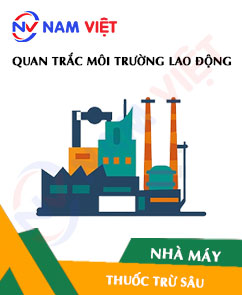
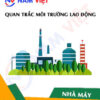
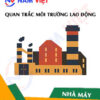
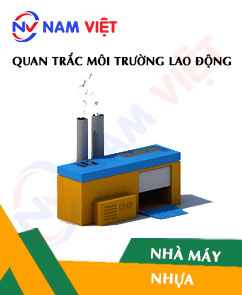





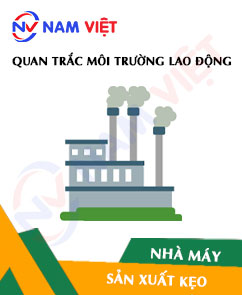

Review Occupational environment monitoring at the pesticide factory
There are no reviews yet.